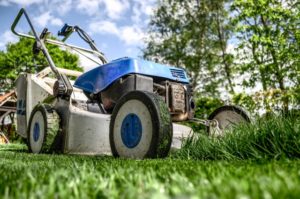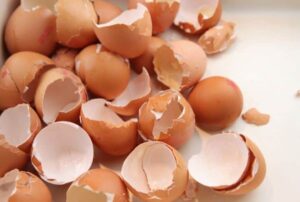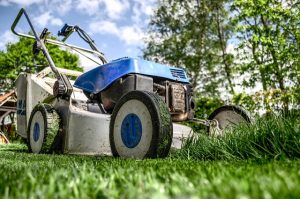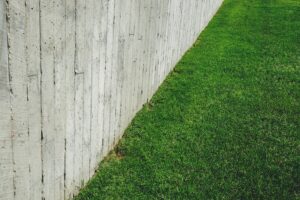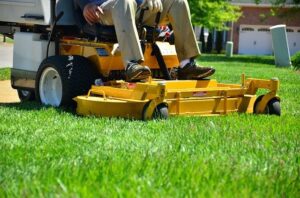Guest Post – 5 Simple Steps to Prepare Your Lawn for Winter the Easy Way

Winter is a tough time for your plants. The days get short, which means less sunshine. The air gets dry, which means less moisture in the soil. And freezing temperatures can damage plant tissues, killing off each plant’s primary food source – its leaves.
When you think about preparing your yard for winter, the first thing you think about is probably your flowers and shrubs. But it’s just as important to prepare your lawn for winter. Grass is no different from your other plants, and it will benefit from a little tender loving care each autumn.
Here are 5 simple steps to make sure your lawn is ready for winter. Pay special attention to the section about fertilizing. This is the area where most people make big mistakes!
#1 – Clean Your Lawn
 The first step you need to take is to clean your lawn up to get it ready for all of the other treatments. There are several different things you can do, and it would be great if you did each of these things before moving on to the next step.
The first step you need to take is to clean your lawn up to get it ready for all of the other treatments. There are several different things you can do, and it would be great if you did each of these things before moving on to the next step.
First, remove all of the debris from your lawn. Pick up any branches, sticks, or twigs that have fallen from your trees and shrubs. Collect all of the leaves that have accumulated during the fall. A good lawn vacuum will make this task go quickly and easily.
Remove any weeds that you can identify. Depending on what type of grass you have, you might need to fertilize very soon, and you don’t want to fertilize your weeds. Pull them out now, and you won’t need to fight them next spring!
Informational : How to Make a Succulent Terrarium in Minutes
#2 – Mow Your Lawn
 I know, I know – you were probably hoping that you were done mowing the lawn for this year. Not so fast!
I know, I know – you were probably hoping that you were done mowing the lawn for this year. Not so fast!
Before you put away your lawnmower for the winter, be sure to give your lawn one last good mowing. You want to mow especially low this time. Cut the grass down to about 1 – 1.5 inches.
Mowing low right now will make the next steps easier and more effective. Even if you normally leave your clippings on the lawn, you might consider bagging them up this time. You’re going to aerate and (maybe) fertilize your lawn next, and it will be good to have a clean surface to work with.
Must Read : 10 Best Plants In Pacific Northwest
#3 – Aerate Your Lawn Have you ever seen those silly looking aeration sandals? They strap onto your feet over your shoes, and the bottoms are covered in long metal spikes. You will want to get a pair of these.
Have you ever seen those silly looking aeration sandals? They strap onto your feet over your shoes, and the bottoms are covered in long metal spikes. You will want to get a pair of these.
Pace your yard, back and forth, to aerate the entire surface as thoroughly as possible. Aerate any areas where grass is growing. You may also choose to aerate your garden beds, although you can skip any areas where you have recently used a garden tiller.
Aeration punctures the soil with many small holes. This allows air, water, and nutrients to penetrate deep into the soil. Aeration is especially beneficial for grass roots, and you want your roots to be strong heading into the winter.
Pro Tip
If you have a large lawn, you might consider using a mechanical aerator instead of wearing aeration sandals. There is a wide spectrum of products available for this purpose. You can use simple hand tools that roll over the surface of the grass – or electric machines that resemble small lawn mowers. Choose a tool that fits your budget and will make aerating your lawn a quick and painless process.
#4 – Take a Soil Test
 Before you consider adding any fertilizer or other amendments to your soil, you should consider taking a soil test to accurately gauge the current status of your soil. There are two primary things you need to look for in your soil. And there are two ways you can go about testing your soil.
Before you consider adding any fertilizer or other amendments to your soil, you should consider taking a soil test to accurately gauge the current status of your soil. There are two primary things you need to look for in your soil. And there are two ways you can go about testing your soil.
The first thing you will be looking for is your soil pH. Most grasses thrive in soil with a neutral pH balance. Highly acidic or alkaline soils can be detrimental to the success of your lawn. Gauge the pH now, and you will know whether or not it should be adjusted.
Next, you will want to gain some understanding about what levels of critical nutrients exist in your soil already. The three primary nutrients are nitrogen, phosphorus, and potassium (N-P-K). All store-bought fertilizers have their N-P-K values clearly indicated on their packaging.
If your soil has an especially high, or low, concentration of any of these three nutrients, you may want to adjust your fertilization accordingly.
To take a soil test, you can either do it yourself using a store-bought soil testing kit; or you can send your soil to a lab for testing by a professional. Sending your soil to a lab will obviously take more time. But the information you receive from a lab will be more reliable than the information you get from any home kit.
Here’s a short video to show you how a home testing kit works:
To locate a lab near you that will test your garden soil, contact your local state university’s agricultural extension office. Or just ask anyone at a friendly garden center near you.
#5 – To Fertilize, or Not to Fertilize
 Fertilization is the area where most people make mistakes when they winterize their lawn. You can purchase a bag of “Lawn Winterizer” at any home improvement store. But these fertilizers are not a good idea for some lawns.
Fertilization is the area where most people make mistakes when they winterize their lawn. You can purchase a bag of “Lawn Winterizer” at any home improvement store. But these fertilizers are not a good idea for some lawns.
You can actually damage your lawn by fertilizing it in the autumn. It all depends on the type of grass you are growing and the area where you live. To take out all of the guesswork, I put together this simple chart to help you decide.
| Type of Grass | Your Local Climate | Should You Fertilize? |
| Warm Season Grass* | Cold | No |
| Warm Season Grass | Warm | Yes |
| Cool Season Grass** | Cold | Yes |
| Cool Season Grass | Warm | Yes |
* Warm season grasses include Bermuda, centipede, St. Augustine, and zoysia.
** Cool season grasses include fescue, Kentucky bluegrass, and perennial rye.
Don’t fertilize in the fall if you have warm season grass in a cold climate. You could force tender new growth that will be easily damaged by an early fall frost. This damage can actually harm the grass roots, weakening the overall health of your lawn.
How Do You Prepare Your Lawn for Winter?
Do you know any tips or tricks that I overlooked? Use the comments below to share them with our audience. I’d love to hear about what methods you use to prepare your lawn for winter.
Author Bio:
Laura is the founder of HumidGarden.com. She loves nature especially when it comes to flowers and different kinds of plants. Humid Garden is created to provide aspiring and inspiring thoughts about gardening for gardeners and anyone who has the intention of keeping a garden.

